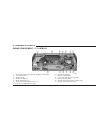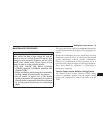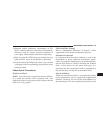
If the coolant (antifreeze) is dirty or contains a consider-
able amount of sediment, clean and flush with a reliable
cooling system cleaner. Follow with a thorough rinsing to
remove all deposits and chemicals. Properly dispose of
old coolant (antifreeze) solution.
Selection Of Coolant
Refer to “Fluids, Lubricants, and Genuine Parts” in this
section for the correct fluid type.
CAUTION!
•
Mixing of coolant (antifreeze) other than specified
HOAT TPIM coolant (antifreeze), may result in
engine damage and may decrease corrosion pro-
tection. If a non-HOAT coolant (antifreeze) is
introduced into the cooling system in an emer-
gency, it should be replaced with the specified
coolant (antifreeze) as soon as possible.
(Continued)
CAUTION! (Continued)
•
Do not use plain water alone or alcohol-base
coolant (antifreeze) products. Do not use addi-
tional rust inhibitors or antirust products, as they
may not be compatible with the TPIM coolant and
may plug the TPIM cooler.
•
This vehicle has not been designed for use with
Propylene Glycol based coolant (antifreeze). Use
of Propylene Glycol based coolant (antifreeze) is
not recommended.
Adding Coolant
Your vehicle has been built with an improved TPIM
coolant (antifreeze) that allows extended maintenance
intervals. This coolant (antifreeze) can be used up to 5
Years or 102,000 miles (170 000 km) before replacement.
To prevent reducing this extended maintenance period, it
is important that you use the same coolant (antifreeze)
throughout the life of your vehicle.
92 MAINTAINING YOUR VEHICLE


















